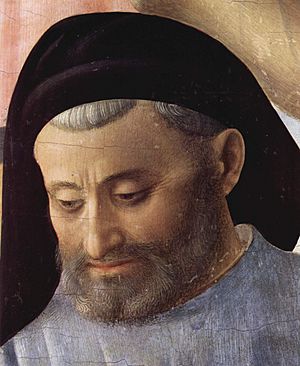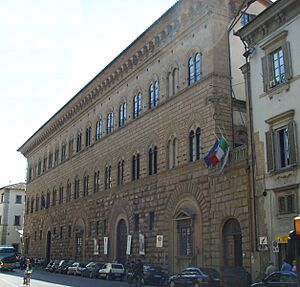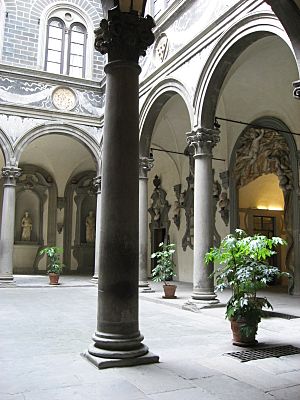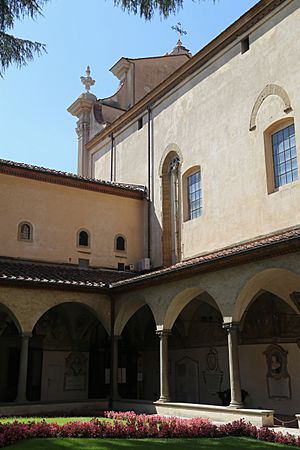Michelozzo facts for kids
Quick facts for kids
Michelozzo
|
|
|---|---|

Fra Angelico's "Deposition"
|
|
| Born |
Michelozzo di Bartolomeo Michelozzi
c. 1396 |
| Died | 7 October 1472 |
| Resting place | Monastery of San Marco |
| Nationality | Italian |
| Movement | Early Renaissance |
| Spouse(s) | Francesca di Ambrogio Galigari (7 children) |
Michelozzo di Bartolomeo Michelozzi (born 1396 – died 7 October 1472) was an Italian architect and sculptor. He was a very important artist during the Renaissance period. Michelozzo was a favorite architect of the powerful Medici family, especially Cosimo de' Medici.
He learned from famous artists like Lorenzo Ghiberti and later worked with Donatello. Michelozzo is best known for designing the Palazzo Medici Riccardi in Florence. Even though he was very talented, he is sometimes less remembered than his famous friends, Donatello (for sculpture) and Brunelleschi (for architecture).
Life Story
Early Years in Florence
Michelozzo was born in Florence, Italy, in 1396. His father, Bartolomeo di Gherardo Borgognone, came from France and worked as a tailor. His family lived in the San Giovanni area of Florence.
We don't know much about Michelozzo's childhood. But we do know he got a good education. He learned to read, write, and do math. In 1410, he started working at the Florentine mint. There, he learned how to engrave dies for coins. This job taught him how to work with metals like copper and bronze. He also became very skilled at making small, detailed sculptures.
In the early 1420s, Michelozzo joined the Arte dei Maestri di Pietra e Legname. This was a guild for master stonemasons, wood-carvers, and sculptors. He even became one of the leaders of this guild in 1430. Michelozzo lived in the same family home on Via Larga for most of his life. This was close to the Medici Palace.
Learning from Masters
Around 1420, Michelozzo began to study with Lorenzo Ghiberti. One of his first big projects with Ghiberti was working on the North Door of the Baptistery in Florence. Michelozzo helped with the detailed finishing work, like chasing and gilding the bronze panels. From Ghiberti, he learned how to run a busy workshop. He also learned how to mix old Roman styles with the Gothic style of his time.
While working with Ghiberti, Michelozzo created a statue of young St. John. This statue is above the door of the Duomo in Florence. He also made a silver statue of John the Baptist for an altar.
Later, Michelozzo worked with the famous sculptor Donatello. They both loved ancient Roman art. Michelozzo helped Donatello with many projects. He often designed the architectural frames for Donatello's sculptures. One example is the tomb for Antipope John XXIII. In 1428, they built an outdoor pulpit together. It was for the Cathedral of St. Stephen in Prato. This pulpit was used to show a famous relic called the Girdle of Thomas. Michelozzo's work was very important in these projects, even though Donatello is more famous.
Important Connections
Working with Cosimo de' Medici
Historians agree that Michelozzo had a very close relationship with Cosimo de' Medici. Cosimo was a powerful leader of the Medici family. Michelozzo was the Medici family's main architect for almost 40 years. Cosimo trusted Michelozzo a lot. He believed Michelozzo was one of the best architects, even better than Brunelleschi in some ways. Michelozzo was also easier to work with than Brunelleschi.
Their strong connection was shown when Michelozzo went with Cosimo into exile in Venice from 1433 to 1434. This showed how much respect and loyalty Michelozzo had for his patron.
Michelozzo designed many important buildings for Cosimo. The large Palazzo Medici in Florence is one of his most famous works. It shows a mix of older Italian Gothic style and the grand classical style. Michelozzo also helped fix and rebuild the Palazzo Vecchio, which was falling apart. He added new rooms and staircases to it.
In 1437, Cosimo paid for the rebuilding of the monastery of San Marco in Florence. Michelozzo was in charge of this project. He redesigned the living areas and the church. For Cosimo, Michelozzo also designed a guest-house in Jerusalem for pilgrims. He also built Cosimo's summer villa at Careggi. Michelozzo rebuilt a strong castle called the Villa Medicea di Cafaggiolo in Mugello. He also built a very large villa at Fiesole for Cosimo's son, Giovanni de' Medici.
Comparing with Brunelleschi
Michelozzo's architectural style was different from Brunelleschi's. Michelozzo often stayed closer to the older Gothic traditions. Some experts say that Michelozzo was the most important architect after Brunelleschi. His buildings are considered very significant works.
Family Life
Michelozzo married Francesca, who was 20 years old, in 1441. He was 45 at the time. Her family gave a good dowry, which showed that Michelozzo's social standing had improved a lot.
Michelozzo and Francesca had seven children: four boys and three girls. Five of them lived longer than their father. Their children were Bartolomeo (born 1442), Piero (1443), Antonia (1445), Niccolo (1447), Marietta (1453), Bernardo (1455), and Lisabetta (1459).
Two of his sons, Niccolò and Bernardo, were partly educated by the Medici family. They might have even lived in the Palazzo Medici when they were young. Both sons later became very successful in Florence's intellectual circles.
Bernardo worked for Lorenzo il Magnifico, teaching his son Piero de Medici. Niccolò also studied with famous thinkers like Marsilio Ficino. He became a secretary for the Medici family and later an ambassador for Florence.
Major Works
Palazzo Medici
In 1444, Cosimo de' Medici chose Michelozzo to design the Palazzo Medici. This was a big deal because Cosimo chose him over the more famous Brunelleschi. The palace's outside looks like older Tuscan palaces. But it doesn't have too many fancy symbols of power. This fit Cosimo's role as a leading citizen.
Michelozzo made the outside of the palace interesting by using different textures of stone. The bottom floor has rough, natural stones. The middle floor has flatter, smoother stones. The top floor has very smooth masonry. This creates a cool visual effect. The palace also has a large, classical cornice at the top. This is a decorative molding that sticks out.
Brunelleschi's ideas influenced the palace's design. You can see this in the windows, which have two arches. The design is also very balanced and symmetrical. The courtyard of the palace also looks like the loggia of the Ospedale degli Innocenti.
The Palazzo Medici was one of Michelozzo's most famous projects. It helped create a new style of palace in Florence. Some of his new ideas for the outside included:
- Using stones that get lighter and smoother as they go up the building.
- Classical columns and decorated tops on the windows.
- A large classical cornice at the very top.
- Smaller cornices dividing the floors.
- The building's strong, rectangular shape.
- The regular placement of the windows.
San Marco Monastery
The San Marco monastery was one of Michelozzo's first and most important projects in Florence. It was built with money from Cosimo de' Medici. Work started around 1437 or 1438. Michelozzo rebuilt the church, the sacristy, the cloister (a covered walkway), the monks' living areas, and the library.
San Marco is sometimes called the first Renaissance church. It mixes older styles with new Renaissance ideas. The plain white walls, without many frescos, were part of Michelozzo's design. He liked large, simple surfaces. He used grey pietra serena stone for important structural parts. Michelozzo was very efficient, and the project was finished quickly. This was also because Cosimo provided enough money.
The church was probably finished by 1443. Michelozzo added a curved apse (the end part of the church). It had three long, round-arched windows. The entrance arch rested on two pilasters (flat columns) with classical tops. The nave (main part of the church) was a single open space. It had altars on each side and a wooden ceiling.
Choir of the Santissima Annunziata
Lodovico Gonzaga asked Michelozzo to design the choir of the Santissima Annunziata church. This was to honor Gonzaga's father. Cosimo de' Medici had already asked Michelozzo to build the church's entrance area.
Michelozzo designed the choir to be round on the inside. He made a dome that was shaped like a half-sphere, similar to the Pantheon in Rome. The outside was ten-sided with deep, curved chapels. Michelozzo tried to make this design even better than Brunelleschi's work.
Santa Croce Church
Michelozzo also added different parts to the church and cloister of Santa Croce. He built a loggia (a covered walkway with open sides) in front of the old dormitory and library. He also worked on the Cerchi Chapel. The details of these parts show Michelozzo's style.
Other Important Buildings
From 1461 to 1464, Michelozzo built the walls of Ston in Dalmatia. These are the largest medieval walls in Europe.
Death and Lasting Impact
Michelozzo died in 1472. He is buried in the monastery of San Marco in Florence.
Michelozzo was one of the most important, but sometimes overlooked, architects of the Early Renaissance. His designs helped shape the look of palaces in central Italy. He also created new ways to design churches. He was good at using traditional styles and adapting them for different places, like Lombardy and Damatia.
His careful work on architectural details influenced many other architects. Artists like Manetti, Bernardo Rossellino, and Giuliano da Maiano learned from Michelozzo's style. His work, along with Brunelleschi and Donatello's, was very important for the development of Renaissance art.
See also
 In Spanish: Michelozzo para niños
In Spanish: Michelozzo para niños




